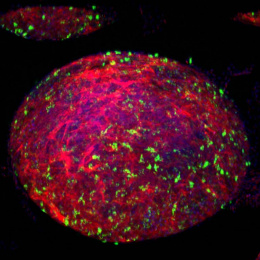Easy Breezy 2: Microparticles in the Lung
Easy Breezy 2: Microparticles in the Lung
Submitted by Gregory Szeto and Adelaide Tovar (Irvine Laboratory) and Jeffrey Wyckoff (Microscopy Core) at the Koch Institute
MIT Department of Biological Engineering, MIT Department of Materials Science and Engineering, Koch Institute at MIT
The lungs are one of the major, fatal sites of metastasis--the deadly process of tumor cells spreading to various organs of the body. In an effort to help protect or "shield" the lungs from this process, we are interested in creating drug depots to focus the effects of strong anti-cancer and immunotherapeutic drugs that may have limited or toxic effects when delivered via traditional administration routes.
This image is one of a series examining lung distribution of drug particles over time after direct intratracheal instillation. For this strategy to be effective, we need to learn and optimize where different particle types are distributing throughout the lungs and how long they persist.
Similar to the route for drugs administered by an inhaler, we have intratracheally instilled micrometer-sized, drug-loaded particles to create drug-releasing depots in the lung. We then imaged whole lungs a few days after dosing to ensure that microparticles (red) remained in the organ; cell nuclei (blue) and cell membrane sugar staining (green).






